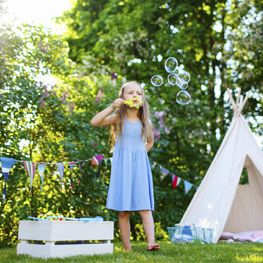
One of the best things about outdoor play is how our children’s imaginations open up and start thinking about objects in a whole new way. Fostering creativity and exploration can be as simple or complex as you’d like to make it. When you’re looking at your yard, the shady spot is often the best to set up kids’equipment - you won’t be struggling to grow a garden there, and your kids and plants won’t overheat from being in a sunny location. Thinking about three main zones in your yard like rooms in your house: ‘Play,' 'Eat’ and ‘Rest’ will help your children transition from one space to another and give you diversity in your days and help combat boredom.
Creating an outdoor area that encourages children to play freely and independently takes some consideration and planning, but the rewards are immeasurable (at least I know my girls crash hard and stay asleep!). Just like we do inside, setting up a few guidelines or rules for playing outdoors will help keep your parental sanity, but also challenge your kids to work within some limits. For example, sand stays in the sandbox (and water stays out) or dirt stays in the flowerbed.
In my experience, kids are attracted to mixing two main outdoor materials: something wet and something solid. Sand, dirt and gravel; all are better when mixed with water for an excellent concoction of ‘monster soup’ as it’s known in our household. Mixing and measuring develops early math and science skills, so letting our children experiment is helping their brains grow. Head to the dollar store for cheap sand toys, colanders and measuring cups to keep little hands busy and thinking. A shallow plastic baby pool or water table can contain these mixtures your child is apt to make; a cleaning bucket works just as well too or a large plastic storage container.
In our yard, we rescued an old pond a neighbor was going to toss to become our sandbox. Placed next to the water barrel, we’ve got two (nearly free) resources that provide hours of entertainment. Keeping your ‘dirty’ zone away from other play structures (houses, slides, swings, trampolines and eating areas) makes yard cleanup a little easier (muck is muck is muck, and we just have to sigh and let it happen).
Kids love nothing more than miniature versions of all grown-up things: houses, tents, tables and chairs. Kid-sized things always go over well - a little space that is fun to watch a parent squeeze into always induces a couple giggles, but really it gives them 10 square feet of ownership they need to respect and take care of. Shelter also gives our children respite from the sun. Shade during the mid-day hours is encouraged and generally welcomed by children. A used tent, be it a play or a small two- to three-person camping tent, is an affordable option. Bonus: It packs away too if space is at a premium. If your child has a few favorite ‘inside’ toys that give you that needed quiet time, why not let this clean shady space be an area they can play with them outside? Don’t be afraid to let a few things wonder between inside and outside.
When kids are busy, we know they’re less likely to stop and eat and drink, so making sure the kids have all they need out and ready keeps energy drain at bay. A small eating area set up with ice-cube water, fluid-filled fruits and veggies, and other energy-providing snacks help keep kids outside. A small picnic table or even simpler, a blanket under an umbrella, are both great options for dining al-fresco with kids. Bring out a couple pillows to prop yourself up on or take a rest with the kids and look up and find shapes in the clouds. Talk about how clouds are formed and you’ve secretly snuck in a science lesson!
Speaking of snacks, edible options in the garden make for interesting conversations and more early learning. A little planter box, containers with plants or a small garden plot also teaches our children about nurturing actions and nourishment for our bodies. Kids will be fascinated by edible flowers: pansies, nasturtium or the smell of many wonderful herbs: rosemary, basil, dill, fennel. Tomatoes and strawberries are easily grown in containers. If your child is a bug enthusiast, consider sunflowers to attract bees or purple coneflowers to attract butterflies.
Playing outside, especially for younger children, still requires some guidance and help when it comes to problem solving and those ‘I don’t know what to do’ moments. Be prepared to get your hands in the muck, plan an obstacle course, kick a ball or jump through the sprinkler.
Kourtney is a mom to two girls aged five and two. She likes to think she’s got a fabulous garden and has discovered there’s not enough space to plant all the peas her girls eat over the summer. She is the owner of The Chipper Nest, an interior decorating company that plans livable, lovable and lively spaces for familes and children. Her work can be found at thechippernest.com or through Instagram @thechippernest.
Calgary’s Child Magazine © 2024 Calgary’s Child